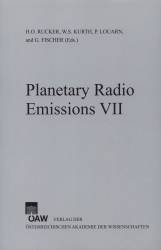
Planetary Radio Emissions VII, pp. 521-532, 2011/12/28
Proceedings of the 7th International Workshop on Planetary, Solar and Heliospheric Radio Emissions held at Graz, Austria, September 15–17, 2010

According to the special Program of the National Academy of Sciences of Ukraine, creation of the new giant Ukrainian radio telescope (GURT) was started a few years ago on the UTR-2 radio telescope observatory. The main goal is to reach maximum band at the lowest frequencies (10-70 MHz), effective area (step-by-step up to 100,000 sq.m), and high interference immunity for resolving many astrophysical tasks when the sensitivity is less limited by the confusion effects. These tasks include stellar radio astronomy (the Sun, solar wind, flare stars, pulsars, transients) and planetary one (Jupiter, planetary lightnings, Earth ionosphere, the Moon, exoplanets). This array should be complementary to the LOFAR, E-LOFAR systems. The first stages of the GURT (6 x 25 cross-dipole active elements) and broad-band digital registration of the impulsive and sporadic events were tested in comparison with the existing largest decameter array UTR-2.